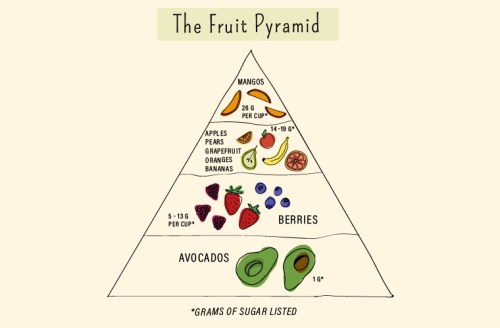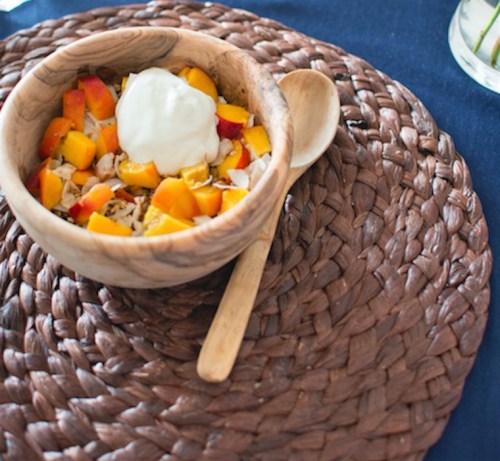If you’re trying to cut back on sugar, you know you need to chuck the chocolate bars and pumpkin spice lattes. But when it comes to fruit, things are a little more complicated.
Sure, fruit is full of vitamins A, B, and C (among others)—all of which your body needs. But fructose can spike blood sugar levels, even with all that fiber to help slow absorption. “I’m definitely pro-fruit, but it is possible to over-consume it,” confirms nutritionist Stephanie Middleberg, MS, RD, CND.
To make sure you’re getting your recommended daily servings without a sugar high, we created the “fruit pyramid,” a handy guide to the best low-sugar option to peel open or pop in your blender. Because swearing off, say, brain-boosting blueberries in the name of health just doesn’t make sense.
Here are the best fruits to eat if you’re watching your sugar intake—and how you should eat ’em.

Avocados at the bottom, mangos at the top
The amount of sugar in fruit varies widely, which is why it’s so helpful to keep the pyramid in mind. If you’re watching your sugar intake, you want to eat more from the base and be a bit more portion-focused with the fruits at the top.
The bottom options that are lowest in sugar? Avocado, Middleberg says, which only has a little over one gram of sugar per cup. Plus, the fiber and healthy fats are super-filling, which can help curb your cravings throughout the day. In other words: The beloved green guy is about as good as it gets.
Next up? Berries, according to Middleberg. “They’re satisfying, and one cup can really feel like a lot,” she notes. One cup of raspberries has 5 grams of sugar, a cup of strawberries has 7 grams, and a cup of blueberries has 15 grams.
Other low-ish sugar/mid-pyramid fruits include grapefruit (a half has roughly 8 grams of sugar), oranges (9 grams), bananas (14 grams), pears (17 grams), and apples (19 grams)—all of which Middleberg really likes because they’re not fruits people tend to overeat. “Some of this has to do with crunch factor,” she says, “while others, like grapefruit and oranges, are appealing because they can be ‘activity’ foods, meaning you really have to work to eat them.”
Topping the pyramid? Mangos, which pack 26 grams of sugar per cup. They’re definitely still good for you—full of fiber and vitamins A, B, and C—but Middleberg suggests sticking to a serving size of one cup is key.

Pay attention to pairings
Smart fruit consumption isn’t just about how much you eat, but what you eat it with. Pairing your fruit with a protein and healthy fat will not only round out the nutrient profile of your meal; it’ll keep you satiated longer, so you’re less likely to keep noshing until you’ve had the sugar equivalent of a Snickers. (No, it’s not the same thing, but you get the point.)
Middleberg’s go-to pairings? Try your fruit with some nut butter, yogurt or ricotta, or a handful of almonds for a way more satisfying snack.
And remember, no one is saying that fruit is bad. Like anything else, it’s all about balance. Picking from the base of the pyramid when possible—and being smart about pairings—can really help you get all the benefits of fruit, without the gnarly side effects of too much sugar. And that is a very sweet prospect, indeed.
Want to balance out your fruit smoothies with some greener options? Check out these fruitless options. Plus, find out why Blake Lively cut soy, not sugar.

Sign Up for Our Daily Newsletter
Get all the latest in wellness, trends, food, fitness, beauty, and more delivered right to your inbox.
Got it, you've been added to our email list.











